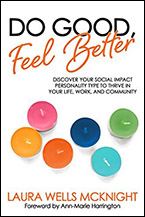Article first published as Book Review: ‘Do Good, Feel Better' by Laura McKinght on Blogcritics.
January 16, 2016
Do Good, Feel Better:
Discover Your Social Impact Personality Type to Thrive in Your Life, Work, and Community
Laura McKnight
Aviva Publishing (2017)
ISBN: 978-1-944335-37-3
Book Reveals That Our Social Impact Personality Type Determines How We Do Good
 Do Good, Feel Better, by Laura McKnight, is a feel-good book that will make you realize how you can feel even better by doing good—and perhaps best of all—in the ways that best suit you.
Do Good, Feel Better, by Laura McKnight, is a feel-good book that will make you realize how you can feel even better by doing good—and perhaps best of all—in the ways that best suit you.
Almost everyone wants to do good—to help those in need and to make the world a better place—but too often, we feel guilty when we have to say no, or we have too many other obligations for us to focus on doing good, or we just don’t feel comfortable with the ways to do good that are available to us. All that will change for you once you read Do Good, Feel Better because you’ll discover what your Social Impact Personality Type is and the best ways to do good according to your personality.
McKnight reveals that there are three Social Impact Personality Types: Activator, Connector, and Investor. She defines them as follows:
“Connectors prefer to engage in social impact activities that are social in nature, involving the opportunity to get together with other people, although not necessarily in pursuit of a specific charitable endeavor.
“Activators are passionate about participating in the causes they care most about, and tend to focus on ‘changing the world’ and impacting one or more social issues on a broad scale.
“Investors prefer to engage in social impact activities that are independent and do not require scheduling dedicated time or working directly with others in the pursuit of a charitable endeavor.”
McKnight also offers a quiz at her website to help people determine which type they are. She then walks readers through the 10 Ways to Do Good, a list she derived from years of research and interviewing thousands of people. Some of the ways to do good may be surprising, while others may seem obvious. For example, volunteering makes the list, but so does purchasing—where you purchase items because the company manufacturing them will give a percentage of the sales to a worthy cause. Other ways to do good include marketing, recycling, and sharing. The great thing about these 10 Ways to Do Good is that each way has components that will work for you no matter whether you are an Activator, Connector, or Investor. And McKnight gives examples of how each way is applicable to each personality type.
These connections McKnight reveals are great because they make doing good all about how the individual wants to do good. Ann-Marie Harrington, the founder of Embolden, who works today with McKnight at RenPSG, North America’s largest independent provider of philanthropic solutions, highlights this point in the book’s Foreword:
“[T]his book is about—you. It’s about realizing what truly gets you going when it comes to doing good and, equally as important, just how much good you’re already doing. By learning about the different ways to do good and finding your Type, the good just grows—along with all the positive feelings that come with knowing you’re changing the world, adding meaning, making a social impact, and building on your own success.”
As an extra bonus, the book doesn’t stop after it walks readers through the 10 Ways to Do Good. The second half is composed of numerous helpful articles that answer questions many people may have about doing good. These articles cover such topics as what you need to know if you set up your own charity, what kinds of charitable contributions are tax deductible, and how you can figure out the best ways to motivate your employees to do good in ways they want to. There’s even a list of 100 things you may need to know in the process of doing good. There’s also advice on how to research charities to determine “Is it a charity, or is it a mystery?” Sometimes it’s hard to know which causes are most deserving of our dollars, so McKnight discusses a solution to that conundrum in the form of donor-advised funds. Finally, I appreciated that she discussed the issue of guilt that arises when you say no to certain causes; she advocates for simply doing good in the ways that work and feel best to you.
After reading Do Good, Feel Better, I did feel better about doing good. I even gave money to a homeless person, whom previously I never would have approached because of fear. I also rethought what I should and shouldn’t say yes to and which causes were important to me. I already give to several charities and non-profit organizations each year, but this book made me realize I was doing good in ways I hadn’t thought about and also how I might do good in new ways.
I believe any individual will benefit from this book, and I especially recommend it to any business owners who want to do good in their community and get their employees motivated to do the same.
For more information about Laura McKnight and Do Good, Feel Better, visit www.DoGoodFeelBetter.com.
— Tyler R. Tichelaar, Ph.D. and award-winning author of The Best Place and Narrow Lives

